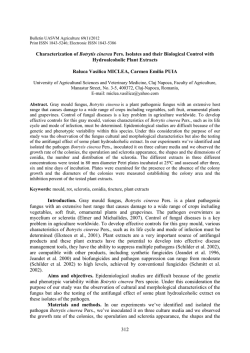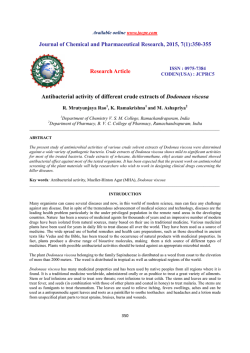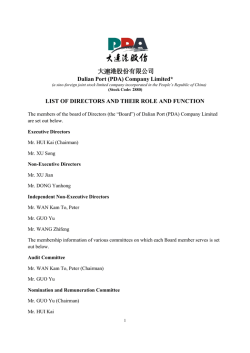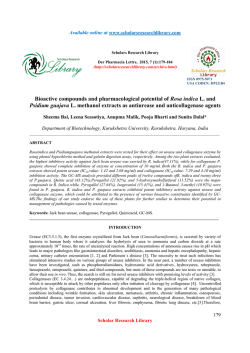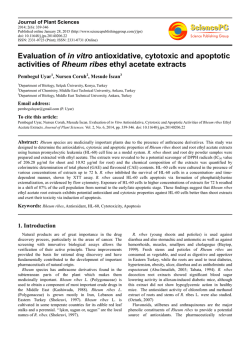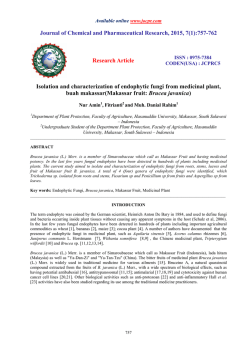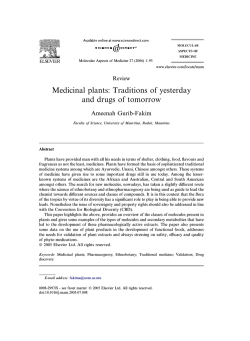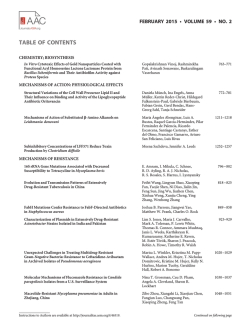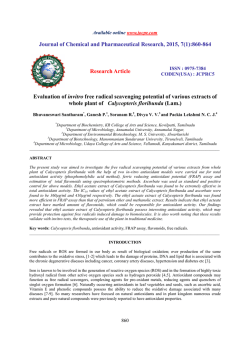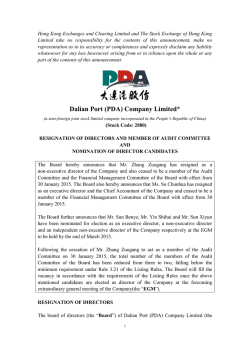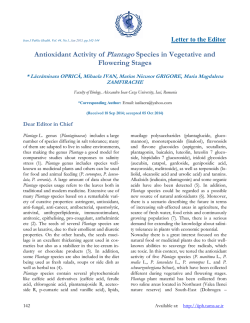
In Vitro Studies Regarding the Biology and the Bio
Bulletin UASVM Agriculture 69(1)/2012 Print ISSN 1843-5246; Electronic ISSN 1843-5386 In Vitro Studies Regarding the Biology and the Biological Control of some Botrytis Cinerea Pers. Isolates Raluca Vasilica MICLEA1), Carmen Emilia PUIA1) 1) University of Agricultural Sciences and Veterinary Medicine, Cluj Napoca, Faculty of Agriculture, Mănăștur Street, No. 3-5, 400372, Cluj-Napoca, Romania, E-mail: [email protected] Abstract. Botrytis cinerea Pers., attacks more than 250 herbaceous and arborescent species of plants being a pathogen spread across the world. This plant pathogen is the main body responsible for the occurrence of grey mould in grapes and other vegetables and fruits. The purpose of the research was the observation of the morphological and cultural characteristics of some isolates of the pathogen as well as the biological control with hydroalcoholic plant extracts. In our experiments we’ve identified and isolated the pathogen Botrytis cinerea Pers., we’ve inoculated on three culture media PDA, Czapek – agar, MA. The features that we observed were the growth rate of the colonies, the sporulation and sclerotia appearance, the shapes and the dimensions of conidia, the number and distribution of the sclerotia. The results obtained consist in differences of morphology, number and distribution of the sclerotia and dimensions of the conidia. For the control with plant extracts of the fungus the isolates were inoculated on PDA medium that contained the extract using the poison food technique. The fungistatic effect of the extracts was established by examining the presence or the absence of the colony growth. The diameters of the colonies were measured and in order to establish the growth inhibition of the fungus it was calculated the surfaces of the colonies that appeared on the treated plates using the ellipse area formula. The results obtained were expressed as inhibition percentage of mycelia growth compared with the dimensions of the control colony. Keywords: mould, Botrytis, disease, tincture, plant extracts Introduction. Pathogenic fungus spread all over the world, Botrytis cinerea Pers., attacks over 250 herbaceous and arborescent species. Botrytis cinerea Pers. ex Fr. is an important necrotrophic fungal pathogen belonging to the subphylum (imperfect fungi) Deuteromycotina, class Hyphomycetes, order Hyphales (Moniliales), family Moniliaceae (Carmen Puia, 2005). Considerable effort is invested in protecting the agricultural products against Botrytis cinerea Pers. before and after harvest. The biological control was used in a large sense for the use of natural products extracted or fermented from various sources. These formulas can be very simple mixtures of natural ingredients with specific activities or complex mixtures with multiple effects on the host organism and the pathogen (Pal and McSpadden Gardener, 2006). Micales et al., (1994); Beever (2003); Mares et al. (2004) cited by Zarins et al. (2009) have shown that extracts from various plants including conifers have fungicidal and insecticidal effect and are receptive to produce biological products. The success of biological control against gray mould depends on the knowledge of ecology and epidemiology of Botrytis cinerea Pers. (Elmer and Michailides, 2007; Elmer et al., 2005). Studies of the literature suggest that phytopreparations are one of the means of future biological protection of the plants. The impact of these preparations is sufficient of efficient, the extraction is not difficult and long, they are environmentally friendly and break down quickly in agrocoenoses and their use is usually effective. Aims and objectives. The aim of the current paper was to study the biology of different isolates of the fungus and the effect of the hydroalcoholic plant extracts for eficiency 300 against Botrytis cinerea Pers. in laboratory tests, as the first step towards development of a biological control system for control of Botrytis. Materials and methods. A total of eight isolates, collected from different locations, were isolated from pepper, lettuce, tomato, hot pepper, eggplant, raspberry, blackberry and strawberry. All isolates were purified and grown on potato dextrose agar medium (PDA) at 25°C. After obtaining the pure cultures of the pathogen this was transplanted on three culture media PDA, Czapek-agar and Malt agar (MA) in order to observe the characteristics of the fungus on different media conditions. Morphological characteristics such as conidial dimension were measured and were observed the color of the conidiophores and the conidia and also their shape. Fresh Aloe arborescens herba and dry Satureja hortensis and Aristolochia clematitis herba (leaves, stems and flowers fragments of 0.5 - 1 cm) and Helleborus purpurascens dry rhizomes were extracted with 70% ethanol in the Plant Pathology Laboratory of USASMV Cluj Napoca, Romania. Inhibition of mycelia growth was assessed using the Poison Food Technique in PDA. PDA was autoclaved and cooled in a water bath to approximate 45ºC and the extracts were added to the medium in each concentration (4 µg/ml, 6 µg/ml, 8 µg/ml) and then were poured into Petri dishes. Results and discussion. The growth rate of the colonies was higher on the PDA medium compared to the Czapek - agar and MA media. The conidia were ellipsoidal, globose to subglobose and smooth. The biometric data of the Botrytis cinerea Pers. varied depending on the isolate type and the culture media. The conidia taken directly from the host plants fell in the range of 14.08 - 9.10 μm (length) x 10.28-7.60 μm (width). Sclerotia varied in number and distribution having the following distribution patterns: in concentric rings, on the edge of the Petri plate and irregular. The hydroalcoholic plant extracts from Aloe arborescens, Satureja hortensis, Helleborus purpurascens and Aristolochia clematitis had an inhibitory effect on Botrytis cinerea Pers., the inhibitory action depended on the type of plant extract and its concentration in the nutritive medium. In all the isolates case, at nine days after the inoculation, the extracts have kept their antifungal properties. From the tested extracts, on the development of the fungus colonies, the most pronounced fungistatic effect had the Aloe arborescens and Helleborus purpurascens extracts because these extracts had the biggest inhibition percent of the colonies growth. Conclusion. Our study shows that there were substantial differences in the morphology, the growth rate and the density of sclerotia but only minor differences in the size of the macroconidia. The fungistatic effects of the extracts was the highest at 8% concentration. Even at 4% concentration the extract of Satureja hortensis had inhibited 100% the lettuce isolate and the Aristolochia clematitis tincture had the same effect on the tomato isolate. REFERENCES 1. Elmer P. A. G., T. J. Michailides, 2007, Epidemiology of Botrytis cinerea in orchard and wine crops, În Y. Elad et al. (eds.), Botrytis: biology, pathology and control, 243-272. 2. Elmer P.A.G., S.M. Hoyte, J.L. Vanneste, T. Reglinski, P.N. Wood, F.J. Parry, 2005, Biological control of fruit pathogens, Fruit Disease Management, 58:47-54. 3. Pal K.K., B. Mcspadden Gardener, 2006, Biological Control of Plant Pathogens, The Plant Health Instructor; 25p. 4. Puia Carmen Emilia, 2005, Fitopatologie. Patografie. Etiologie, Ed. Risoprint, Cluj Napoca 5. Zarins Ivars, M. Daugavietis, Julija Halimona, 2009, Biological activity of plant extracts and their application as ecologically harmless biopesticide Scientific works of the Lithuanian Institute of Horticulture and Lithuanian University of Agriculture. sodininkystė ir daržininkystė, 28(3). 301
© Copyright 2025
